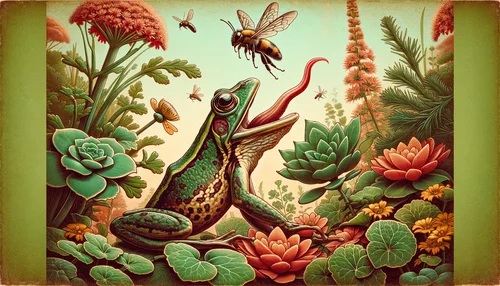Are frogs and toads good for your garden? Absolutely, and here’s why. Gardens are not just assemblies of plants and soil; they form a vibrant ecosystem where every inhabitant contributes to the overall health and balance. Among these beneficial creatures are frogs and toads, whose roles are often underappreciated. You might notice them blending seamlessly into the foliage or hear their songs echo through the garden after a rainstorm. These amphibians are more than mere background noise; they actively manage pest populations and enhance biodiversity, making them invaluable allies in the garden’s complex web of life.
Basic Facts of Frogs and Toads
These amphibians do more than add a touch of wilderness to your garden. Their presence indicates a healthy environment, and they contribute significantly to maintaining the delicate ecological equilibrium of our green spaces. Despite their shared roles in the garden, frogs and toads are distinct creatures with unique characteristics and benefits.
Frog Facts
- Physical: Smooth, slick skin and robust legs for jumping. Possess teeth in both upper and lower jaws to aid their carnivorous diet.
- Habitat: Typically bound to moist environments like creeks, ponds, swamps, and rainforests (found on all continents except Antarctica).
- Diet: Start as tadpoles with a vegetarian diet, then shift to eating insects, worms, spiders, slugs, and snails as adults. Use long, sticky tongues to snatch prey.
- Reproduction: Return to water to breed. Females lay eggs in clusters that resemble bunches of grapes, usually in or near water.
- Defenses: May possess glands that make them distasteful to predators, but not as strong as toads.
Toad Facts
- Physical: Dry, warty skin and shorter legs for hopping rather than jumping. Lack teeth.
- Habitat: More versatile, able to live further from water sources in drier areas.
- Diet: Similar to frogs, starting as vegetarian tadpoles then becoming carnivorous adults eating insects, worms, etc. Tend to wait for prey to come close.
- Reproduction: Return to water to breed. Females lay eggs in long, string-like chains wrapped around vegetation in or near water.
- Defenses: Especially known for toxic or unpleasant-tasting skin secretions to deter predators.
While many may not realize it, frogs and toads serve as unsung heroes in the garden by controlling pests and supporting local wildlife. As dusk falls and the garden calms, these amphibious allies begin their nightly duties, feasting on what we consider ‘garden pests’—a natural behavior that underscores their role as valued garden guests.

Natural Pest Controllers
Imagine having a garden where you rarely need to use pesticides. That’s the kind of environment that frogs and toads can help create. These amphibians are great at eating insects and slugs, making them excellent allies in your fight against garden pests. Frogs usually eat a wide variety of bugs, such as flies, mosquitoes, and moths, while toads are known for their appetite for slugs and beetles. Therefore, these creatures can significantly reduce the pests that often damage our plants. In the garden season, a single frog or toad can consume up to 10,000 pests.
Biological Pest Control
Frogs and toads contribute to biological pest control. This is the process of using living organisms to reduce pest populations, and it’s a method that’s as old as agriculture itself. It has numerous benefits. For one, it reduces the reliance on commercial pesticides, which are harmful to the environment and to non-target organisms, including beneficial insects, birds, and even pets and humans.
The Benefits of Frogs and Toads
When you invite these amphibians into your garden, you’re opting for a more sustainable and organic approach to pest management. By letting nature take its course, you often find that intervention goes down while biodiversity and garden health go up. Moreover, having frogs and toads as pest controllers can make your gardening experience even more rewarding, knowing that you’ve created a space where nature thrives.
As we move on to considering the broader ecological role of frogs and toads, remember that their presence is an indicator of environmental health. Ponder for a moment—their beneficial reach extends far beyond pest control, indirectly improving soil quality and contributing to a balanced garden ecosystem.
The Ecological Role of Frogs and Toads
Frogs and toads are far more than mere pest controllers in the garden; their role in the ecosystem is multifaceted and vital for maintaining a natural and sustainable environment. Their presence not only supports a more balanced ecological framework but also indicates a thriving, healthy garden habitat.
Soil Health Enhancement
First and foremost, amphibians like frogs and toads significantly contribute to soil health. Their natural behaviors, including moving, digging, and burrowing, help to aerate the soil. This aeration is crucial as it improves water infiltration and creates space for plant roots to expand, fostering stronger and more resilient plants. These activities also add vital nutrients, organic matter, and moisture to the soil, enhancing its productivity and overall health. Through these actions, amphibians act as “ecosystem engineers,” vital for maintaining the soil’s quality and fertility.
Link in the Food Web
Amphibians are key players in the garden food web, serving as prey for birds, snakes, and larger mammals. This dynamic contributes significantly to the overall health of the garden as frogs and toads help manage the population levels of these predators. By doing so, they prevent any single species from becoming overdominant, thereby maintaining a balanced ecosystem and reducing risks to the garden’s health.
Environmental Health Indicators
Finally, the presence of amphibians like frogs and toads is a strong indicator of environmental quality. These sensitive creatures are often the first to react to pollution and chemical imbalances. A thriving population in your garden suggests a low level of pollutants and a well-balanced ecosystem, serving as a natural gauge of ecological health.
By understanding and appreciating the comprehensive roles frogs and toads play in your garden, you can recognize them not just as simple garden dwellers but as essential contributors to its ecological and environmental welfare. Their varied functions underscore the importance of preserving these amphibians to ensure a robust, sustainable garden ecosystem.
Please read my post on The Essential Guide To Garden Beneficial Organisms for a full guide to beneficial organisms.
Welcoming Frogs and Toads to Your Garden
Encouraging frogs and toads to visit and make a home in your garden involves several thoughtful strategies to create a suitable habitat for them. Here’s how you can invite these beneficial amphibians to enhance the biodiversity of your garden.
Provide a Consistent Water Source
Water is essential for the lifecycle of amphibians. You can attract them by adding a shallow water container, pond, or other features where they can drink and breed. It’s important to keep the water clean and change it regularly to avoid breeding mosquitoes.
Create Safe Shelters
Frogs and toads need hiding spots to feel safe in your garden. You can create shelters using rock piles, overturned flowerpots propped up to form “toad houses,” or areas thick with leaf litter and dense vegetation. Arranging stones to form small caves or similar structures can also provide excellent refuge for these creatures.
Eliminate the Use of Chemicals
To make your garden a safe haven for amphibians, cease using pesticides, herbicides, and synthetic fertilizers, which can be toxic to them. Adopting organic gardening practices ensures a healthy, chemical-free environment that supports not only amphibians but the overall ecosystem of your garden.
Plant a Diverse Selection of Native Plants
Incorporating a variety of native plants will enrich your garden by providing food, shelter, and breeding grounds for frogs and toads. Aim to include a mix of tall plants for climbing and shorter plants with broad leaves for hiding, which help mimic their natural habitats.
Attract Beneficial Insects
Ensuring a steady presence of insects like bugs, beetles, and caterpillars will offer a natural food source for frogs and toads. This not only helps in maintaining their population but also aids in the biological control of pests in your garden.
To ensure sustainable growth, consider your local climate and native amphibians. Consult wildlife experts to create a safe environment for these creatures. Adopt practices that don’t harm their populations or disrupt local habitats. By creating an inviting and inviting environment, you can encourage these beneficial creatures to thrive in your garden.
In closing, by taking these actions, you not only aid in the health of your garden but also contribute to the conservation of frogs and toads. Both play vital roles in our ecosystems, and their presence is a sign of a healthy, thriving garden. With just a few adjustments, you can welcome these creatures into your space, allowing you to observe their fascinating behaviors while they work alongside you to maintain a more natural and productive garden.

